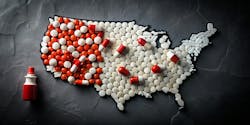Quantifying IHC data from whole slide images is paving the way toward personalized medicine
Pathology addresses the four components of disease: the cause, the mechanisms of its development, the morphological changes induced by the disease, and its clinical manifestations.
Pathologists make the definitive diagnosis of disease based on tissue samples resected from a patient. Their diagnosis relies on gross and microscopic examination of the tissue combined with the results of additional tests, such as immunohistochemistry (IHC), to evaluate protein expression.
Proteins play a pivotal role in both normal and disrupted physiological processes, and IHC is an efficient and economical method of visualizing and locating protein expression in tissue specimens. For this reason, IHC is playing a growing role in surgical pathology for diagnosing various diseases, and providing prognostic information to help guide more personalized therapy.1
Whole-slide imaging (WSI) is involved in a growing number of applications for pathology. Scanning an entire histological slide, at high magnification, will generate a digital slide in only a few minutes. Computer-aided image analysis of digital slides can then be used to extract objective and quantitative data from image features, to characterize biomarker distribution for clinical assessment.
A notable example of a biomarker used to guide targeted cancer therapy is human epidermal growth factor receptor 2 (HER2), a prognostic and therapeutic biomarker for patients with breast cancer. Up-regulation of the HER2 gene, which is accompanied by an over-expression of the corresponding protein, occurs in 10 percent to 30 percent of breast cancer cases and is associated with poor prognosis.2 HER2 is the target of trastuzumab, a therapeutic monoclonal antibody that improves the prognosis of patients suffering from HER2-overexpressing breast cancers when used in combination with chemotherapy.2
HER2 expression is evaluated for each newly diagnosed breast cancer case, to refine therapeutic choice, and therefore requires highly standardized testing methods. IHC is often chosen in pathology departments as an initial cost-effective assay, over fluorescent in situ hybridization (FISH). While HER2 IHC is used to identify patients who could potentially benefit from adjuvant monoclonal antibody treatment, its microscopic evaluation is manually and visually performed by a pathologist, and relies on his or her semi-quantitative assessment.
In addition to HER2, for each new breast cancer case it is also recommended that the expression of estrogen receptor (ER) and progesterone receptor (PR), two additional prognostic biomarkers, be evaluated.3 The expression of these proteins predicts the patient’s response to hormonal therapies such as Tamoxifen.3 The expression of these hormonal receptors is also evaluated by IHC. In the literature, different scoring systems have been proposed combining the percentage of stained area and discretized intensity levels.4
The scoring of IHC tests can be time-consuming and difficult due to heterogeneity of tumor grade, the absence of precise cut-off values, and variable staining patterns. Despite these problems, this evaluation is used for most common types of cancer, and the drugs developed in this context have gained blockbuster status. Quantifying IHC staining patterns has thus become a crucial need in the pathology practice. Computer-aided image analysis has multiple advantages, avoiding the effects of human subjectivity resulting from manual visual evaluation.5 Image analysis also increases the range of quantitative information that can be extracted from complex IHC staining patterns.
In the majority of laboratories, pathologists perform visual tissue-based biomarker evaluations using a microscope. Many studies have indicated intra- and inter-observer variations for the interpretation of IHC staining such as for HER2, hormone receptors, and Ki67, a cell-cycle marker of proliferation.6-8 Digital pathology plays an important role in improving reproducibility of assessments by promoting the submission of difficult cases to a specialist or a board of experts and by improving the training of younger pathologists. Given the compelling clinical impact of these results, numerous efforts, such as automation and quality controls, have been developed to optimize the IHC technique. Furthermore, image analysis algorithms are designed with the intention of objectively evaluating both IHC biomarkers and tissue morphology to guide therapy. Despite these advances, implementation of image analysis for IHC quantification in daily practice remains controversial.3
Nonetheless, quantitative image analysis is often presented as a means of achieving more precise and reproducible biomarker evaluation measurements. The most common quantitative features used for staining characterization estimate the proportion of labeled cells (or labeling index [LI]) and the staining intensity.9 To evaluate the staining intensity on an image, we use a measure that is inversely correlated to the conventional pixel intensity; i.e., a low staining intensity value corresponds to a weak (light) staining, whereas a high staining intensity value corresponds to a strong (dark) staining. Staining intensity is thus directly correlated to the conventional optical density measurement and is sometimes strictly equivalent to this value (depending on the image analysis software package used).
Numerous studies demonstrate that laboratory personnel can achieve high precision and high accuracy with image analysis of HER2 IHC-stained slides using a laboratory-validated image analysis scoring technique. By some measurements, the image analysis technique performs better than manual assessments. Image analysis appears to have an increased concordance with FISH and better overall inter-observer and intra-observer reproducibility with image analysis methods over manual assessments. Concordance rates with FISH, regarded as the “gold standard” for HER2 testing, often reach the lofty goal of greater than 95 percent or higher, including 100 percent in a study at Mayo Clinic.10-16
In the era of personalized medicine, and as the spotlight grows brighter on laboratory testing, it will become increasingly important for laboratories to demonstrate accuracy, precision, and cost-effectiveness of immunohistochemical testing for proteins such as HER2. Image analysis of digital slides, combined with comprehensive data repositories comparing morphology-based staining results with patient outcomes, will be an important method to achieve these objectives.
References
- Lopez XM, Debeir O, Salmon I, et al. Whole slide imaging and analysis for biomarker evaluation in digital pathology. Microscopy: advances in scientific research and education (A. Méndez-Vilas, Ed.). Formatex 2014.
- Wolff AC, Hammond MEH, Hicks DG, et al. Recommendations for human epidermal growth factor receptor 2 testing in breast cancer: American Society of Clinical Oncology/College of American Pathologists clinical practice guideline update. J Clin Oncol. 2013;31(31):3997–4013.
- Harris L, Fritsche H, Mennel R, et al. American Society of Clinical Oncology 2007 update of recommendations for the use of tumor markers in breast cancer. J Clin Oncol. 2007;25(33):5287–5312.
- Hammond MEH, Hayes DF, Dowsett M, et al. American Society of Clinical Oncology/College Of American Pathologists guideline recommendations for immunohistochemical testing of estrogen and progesterone receptors in breast cancer. J Clin Oncol. 2010;28(16):2784–2795.
- Von Wasielewski R, Mengel M, Wiese B, Rudiger T, et al. Tissue array technology for testing interlaboratory and interobserver reproducibility of immunohistochemical estrogen receptor analysis in a large multicenter trial. Am J Clin Pathol. 2002;118(5):675–682.
- Press MF, Sauter G, Bernstein L, et al. Diagnostic evaluation of HER-2 as a molecular target: an assessment of accuracy and reproducibility of laboratory testing in large, prospective, randomized clinical trials. Clin Cancer Res. 2005;11(18):6598–6607.
- Reisenbichler ES, Lester SC, Richardson AL, et al. Interobserver concordance in implementing the 2010 ASCO/CAP recommendations for reporting ER in breast carcinomas: a demonstration of the difficulties of consistently reporting low levels of ER expression by manual quantification. Am J Clin Pathol. 2013;140(4):487–494.
- Tang LH, Gonen M, Hedvat C, et al. Objective quantification of the Ki67 proliferative index in neuroendocrine tumors of the gastroenteropancreatic system: a comparison of digital image analysis with manual methods. Am J Surg Pathol. 2012;36(12):1761–1770.
- Decaestecker C, Moles Lopez X, D’Haene N, et al. Requirements for the valid quantification of immunostains on tissue microarray materials using image analysis. Proteomics. 2009;9(19):4478–4494.
- Dobson L, Conway C, Hanley A, et al. Image analysis as an adjunct to manual HER-2 immunohistochemical review: a diagnostic tool to standardize interpretation. Histopathology. 2010;57:27–38.
- Masmoudi H, Hewitt SM, Petrick N, et al. Automated quantitative assessment of HER-2/neu immunohistochemical expression in breast cancer. IEEE Trans Med Imaging. 2009;28:916–925.
- Gustavson MD, Bourke-Martin B, Reilly D, et al. Standardization of HER2 immunohistochemistry in breast cancer by automated quantitative analysis. Arch Pathol Lab Med. 2009;133:1413–1419.
- Turashvili G, Leung S, Turbin D, et al. Inter-observer reproducibility of HER2 immunohistochemical assessment and concordance with fluorescent in situ hybridization (FISH): pathologist assessment compared to quantitative image analysis. BMC Cancer. 2009;9:165.
- Minot DM, Kipp BR, Root RM, et al. Automated Cellular Imaging System III for assessing HER2 status in breast cancer specimens: development of a standardized scoring method that correlates with FISH. Am J Clin Pathol. 2009;132:133–138.
- CantaloniC, Tonini RE, Eccher C, et al. Diagnostic value of automated HER2 evaluation in breast cancer: a study on 272 equivocal (score 2+) HER2 immunoreactive cases using an FDA approved system. Appl Immunohistochem Mol Morphol. 2011;19:306–312.
- Minot DM, Voss J, Rademacher S, et al. Image analysis of HER2 immunohistochemical staining. Reproducibility and concordance with fluorescence in situ hybridization of a laboratory- validated scoring technique. Am J Clin Pathol. 2012;137(2):270–276.






